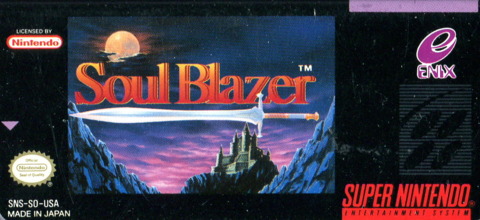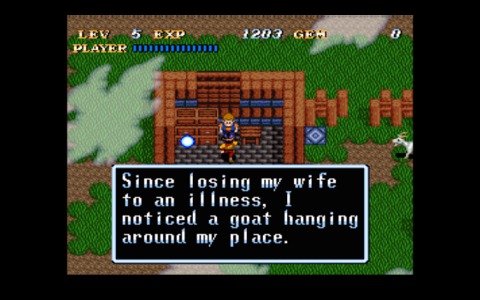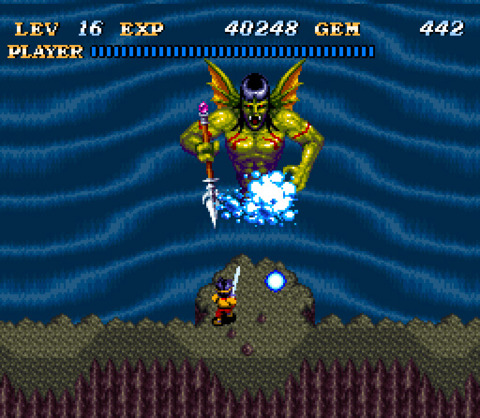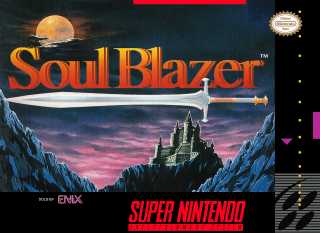Blazin' the Trail

The early-to-mid 90’s set the stage for one of the most beautiful production company and development studio relationships to exist in video games with the pairing of Japanese companies Quintet and Enix. While their first game, ActRaiser, a mesh between classic platforming and Sim City style urban planning, was an insanely fresh, original idea that would lead to their eventual ‘Quintology’ it wasn’t until the release of their next title that the duo would really show their true genius.
Though ultimately not as impactful as it’s predecessor or subsequent spiritual sequel Illusion of Gaia, Soul Blazer for the SNES is a rare gem in the sense that it just feels right by taking the basic framework of ActRaiser and tweaking it in a few simple-yet-effective ways. Instead of side scrolling platformer, this new game would be top down in the vein of Zelda: Link to the Past, while the Sim City-esque city planning of the first game would be simplified in a way that makes the whole thing feel more fluid.
In the game you are an angel sent down by ‘The Master” (real subtle) to free the world from the demon Deathtoll, a being who feeds off the souls of the subjects of the King, who in return is granted great wealth for his treachery. A simple setup that leads to a story arch that is ultimately throwaway but with some actually fun, silly moments.

After the initial exposition, the game opens with your character standing in a green, lush yet empty plot of land overlooking a cave mouth that acts as an entrance into the game’s first dungeon. Upon entering said dungeon, you are immediately attacked by monsters that all issue our from a certain point. Defeating all the monsters turns the spawn point into a switch that the player can step on to interact with and where the games’ primary mechanic enters the picture.
Stepping on said switches will have 1 of 2 possible effects; they will either allow you to progress within the dungeon by opening a pathway or will restore life to that area’s town in the form of NPC’s or buildings that Deathtoll had previously destroyed. The combat is based around simple swordplay not unlike that of the Zelda games and you will receive more powerful swords throughout, which admittedly do nothing to raise the level of fun to be had while monster hunting. However, being granted the ability to cast various spells does provide combat with some variety. Taken in short sessions, the combat can stay relatively enjoyable with some fun bosses, but can get repetitive over long stretches but there are enough dialogue based character interactions to keep the monotony in check.
Whereas ActRaiser split the 2 primary mechanics in a way that made you feel like you were switching off between two seperate games, Blazer sets up a symbiotic relationship between the two, effectively causing them both to be more rewarding. Progressing through a dungeon (the gameplay) leads to story progress in the town (the narrative) to form what is ultimately the games overall experience. And although your character’s actions have a huge impact on the game’s world through what could be a confusing system, the developers don’t waste time spelling it out for you. You act, the world reacts, you learn and you progress.
While there are some memorable story beats, and a few characters that positively add to the story, one of the most impressive aspects of the game is how little of an emphasis it places on narrative. Some would consider this a weakness, but when later games in the series like Illusion of Gaia and Terranigma put a heavier emphasis on story, each with a few moments that work, they ultimately suffer by being overly drawn out. Soul Blazer knows just what it wants to be. It drops you onto a field with one way to go, and you go. Progress occurs within your character, and in world in which you exist, and all at a rate that keeps the areas and supporting characters refreshing.
While the possying up of Enix and Quintet that took place in the 90’s resulted in an outpour of quality SNES titles, Soul Blazer wasn’t exactly the game every kid stared at through the window as they hurried through their Saturday morning list of chores. But, in 2014, with the return of hardcore gaming in successful titles like Dark Souls and the rise of action packed indie titles that focus on fun gameplay over all else, the qualities that make Soul Blazer a truly singular experience have never been more relevant.


